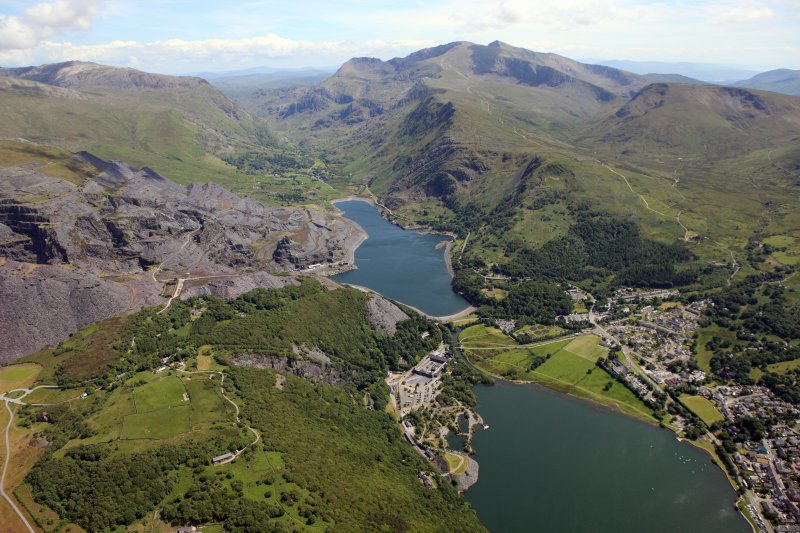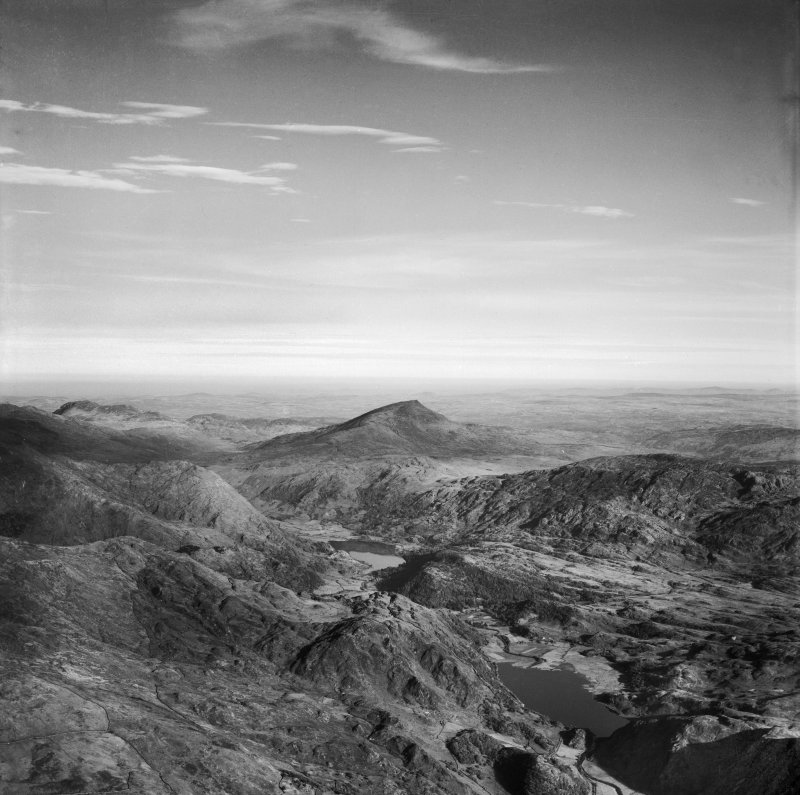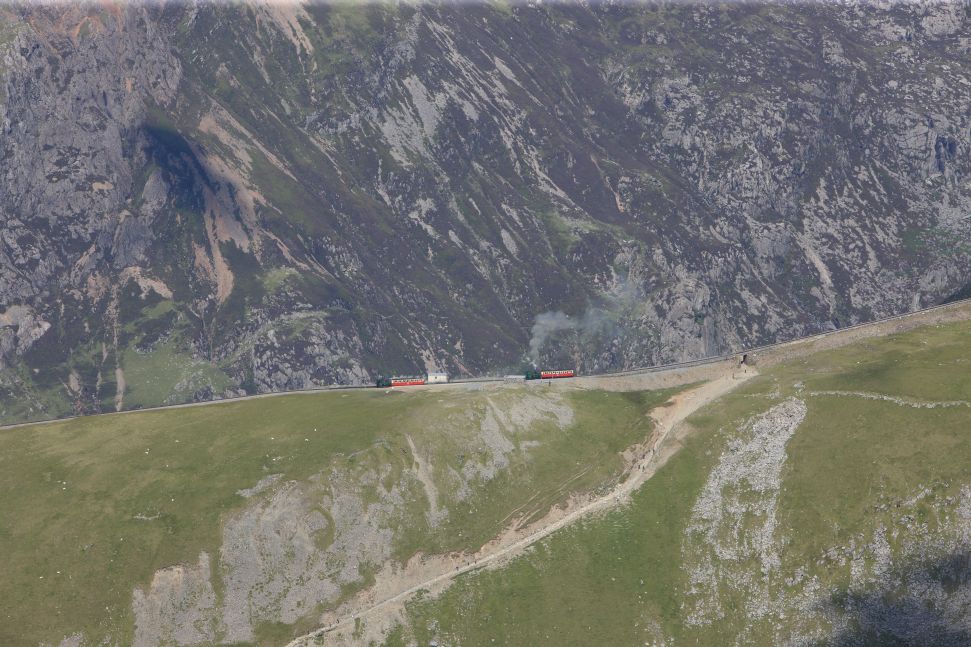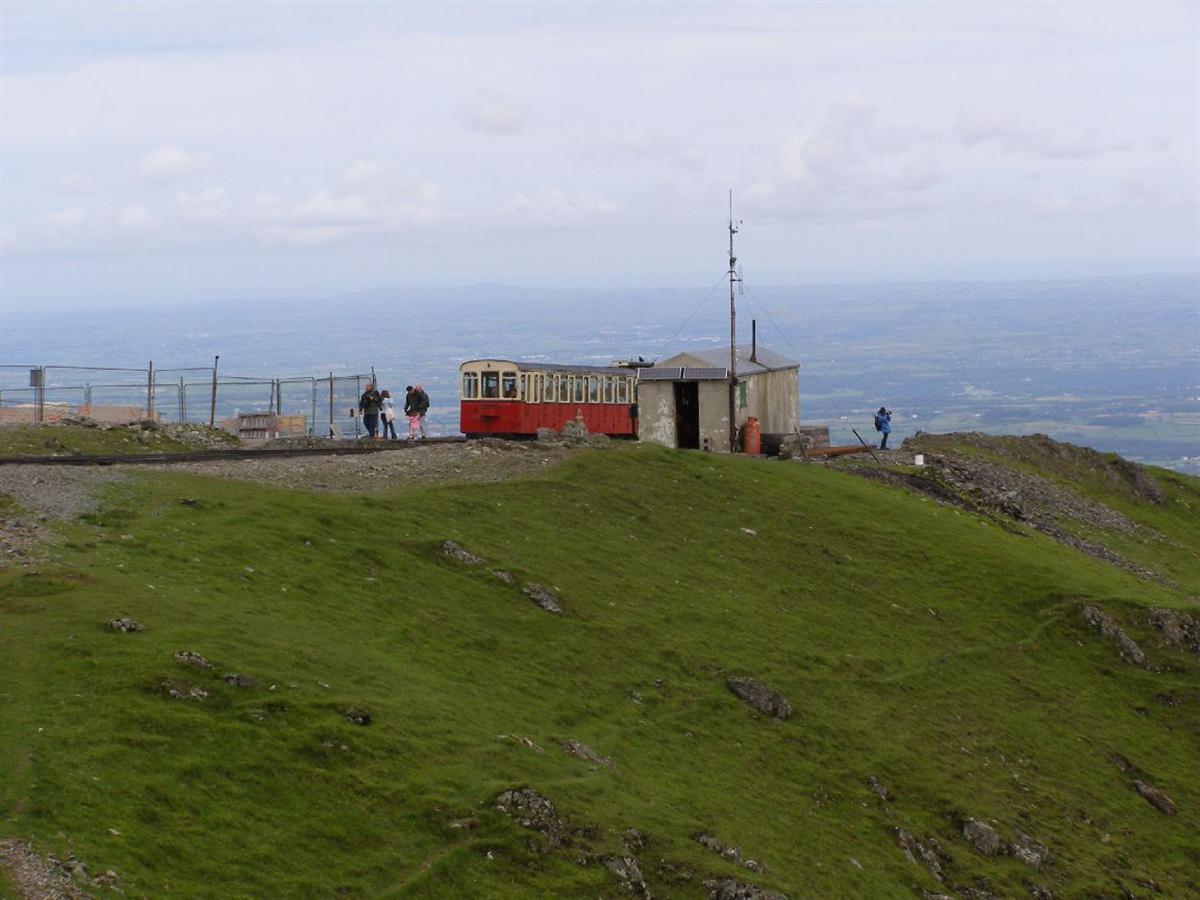Snowdon - Overview
At 1085 metres, Snowdon is the highest mountain in Wales. According to legend, the Welsh giant Rhitta was buried in the summit cairn after he had been slain by King Arthur. The earliest recorded ascent of Snowdon was undertaken by the botanist Thomas Johnson in 1639 and the rise of tourism in the eighteenth century saw an increasing number of visitors to the mountain. New paths were created up the mountain and of the six popular routes in existence today, the easiest, but longest route is the Llanberis Path. The most spectacular ascent of the mountain is via the Snowdon horseshoe which ascends the narrow ridge of Crib Coch and then to the summit of Snowdon before traverseing the 300m high cliffs of Lliwedd, where George Mallory trained for his ill-fated trip to Mt Everest in 1924.
In the early days of modern tourism, local guides offered their services and, for an additional charge, also provided ponies and donkeys to the weary of foot. The first summit hut selling refreshments was established in 1820. Despite the inclement weather, Prince Pückler-Muskau enjoyed a personal bottle of champagne here in 1828. Over the next decade, two rival hotels from Llanberis established their own shelters, named ‘Roberts Hotel’ and ‘Dry Club’. In 1844, the former welcomed the King of Saxony in the company of his physician, Carl Carus.
Towards the end of the nineteenth century, the Snowdon Railway Company was created so that tourists could travel up Snowdon in any weather. Owing to the steep ascent, the company went to Switzerland and bought five special steam trains that were able to push, rather than pull, the passenger carriages up the mountain and return them again safely by engaging their breaks. The first journey took place in 1896, but on the return journey from the summit, the train derailed, probably due to overloading. In the aftermath, the much safer rack and pinion railway system was installed and the same system is still in use today.
Accounts of Travel
Nordland-Fahrten. Zweite Abteilung, c. 1870s
Franz Brömel (1829 – 1904)
Von der höchsten Kuppe, „y[r] Wyd[d]fa“ genannt, d. h. ein großer Todtenhügel, bietet sich eine unvergleichliche Aussicht nach allen Königreichen, England, Schottland und Irland, falls die Musen, welche hier Somerwohnungen besitzen sollen, den Schauenden etwas Besonders zu Liebe thun und einen klaren Tag bescheren. Der Snowdon steht ebenso wie der Brocken im deutschen Harz bei den Touristen in Verruf, daß er gerade im ersehnten Augenblicke sich eine dichte Nebelkappe über die Stirne ziehe. Aber bei klarem Wetter kann das Auge sich volltrinken in Entzücken. Norwärts dämmert Cumberland, das „Land der Seen“, und mancher Grenzhügel von Schottland; östlich reicht der Blick bis in drei englische Grafschaften; südlich ragen die zahllosen Piks von Südwales und nach Westen öffnet sich die gewaltige See, die Weltschiffstraße zwischen Amerika und Liverpool. Wenn die gütige Fee Fata Morgana nicht ihre Zauberei dabei im Spiele hat, kann jener leise graue Streifen in unbegrenzter westlicher Ferne füglich für die Ostküste von Irland gelten. Mitten in der See aber glänzt im Sonnenlicht wie ein schillerndes Juwel die Insel Man; näher zu Füßen schimmert das hainreiche Eiland Anglsey und die Meerbrücke von Menai. Zwischen Bai und Meer glitzern die Kirchen von Caernarvon, der bedeutendsten Stadt von Nordwales, sonst aber blauen in der Tiefe überall Schiefergefilde, die dem Lande seine eigenthümliche Farbe verleien. Dazwischen winken blendenhell die Spiegel vieler kleiner Seen und Lagunen in tiefen Thälern, welche den Windungen des Elwyn, Conwy und des Lledr folgen.
From the highest peak, named ‘yr Wyddfa’, i.e. a tall burial mound, an incomparable view over all kingdoms of England, Scotland and Ireland is to be had, if the muses, who are said to have their summer seats here, deign to be particularly kind to the viewer and present him with a clear day. Just like the Brocken in the German Harz mountains, Snowdon is decried among tourists for pulling a dense fog cap over its forehead exactly at the long-desired moment. But in clear weather, the eye can drink to its full contentedness. Cumberland, the ‘land of the lakes’, and many a Scottish border hill doze in the north; to the east, the view reaches up to three English counties; the peaks of south Wales lie to the south and in the west, the vast sea, the global shipping route between America and Liverpool, unfurls. If the gracious fairy Fata Morgana does not have her magical finger in the pie then the soft grey stripe in the infinite western distance may well be the east coast of Ireland. And like a sparkling jewel in the sun, the Isle of Man lies in the middle of the sea; the richly wooded island Anglesey and the Menai Suspension Bridge shimmer closer to one’s feet. The churches of Caernarfon, the most significant town in north Wales, glitter between the bay and the sea; but otherwise, realms of slate, which give the land its peculiar colouring, shine blue in the deep. In between, the dazzling mirrors of countless small lakes and lagoons beckon from deep valleys which follow the windings of the rivers Elwy, Conwy and Lledr.
Briefe eines Verstorbenen, 1828
Hermann von Pückler-Muskau (1785 – 1871)
Aussichten entschädigten mich nicht, denn von Wolken ganz um schleiert, konnte ich kaum 20 Schritt weit vor mir sehen, und in diesem geheimnißvollen clair obscur erreichte ich auch den ersehnten Gipfel, zu dem man über einen schmalen Felsenkamm gelangt. Ein Steinhaufen, in dessen Mitte eine hölzerne Säule steht, ist als Wahrzeichen aufgerichtet. Ich glaubte hier der Erscheinung meines Doppelgängers zu begegnen, als ein junger Mann aus dem Nebel hervortrat, der mir selbst völlig glich, NB. wie ich aussah, als ich vor 16 Jahren in den Schweizer-Alpen umher irrte. ... Er hatte von der andern Seite den Berg erstiegen, und frug mich nur, ohne sich aufzuhalten, angelegentlich, wie weit der Gasthof, und wie der Weg beschaffen sey? Sobald ich ihm meine Nachrichten mitgetheilt, eilte er singend und trällernd die Felsen hinab, und entschwand bald meinen Blicken. Ich kritzelte unterdeß meinen Namen, neben tausend andern, auf einen großen Stein, und ergriff dann das Kuhhorn, welches mir der Gastwirth als Trinkgeschirr mitgegeben hatte, und befahl meinem Führer, den Stöpsel der Champagnerflasche zu lösen. Sie mußte ungewöhnlich viel fixe Luft enthalten, denn der Pfropf flog höher, als die Säule unter der wir standen, und Du kannst daher, ohne Münchhausen etwas abzuborgen, mit gutem Gewissen versichern, daß, als ich am 17. Juli [1828] Deine Gesundheit trank, der Champagnerstöpsel gegen 4000 Fuß hoch über die Meeresfläche geflogen sey.
I was not compensated for my sufferings by the view, for, shrouded as I was in clouds, I could hardly see twenty paces before me. In this mysterious ‘clair obscur’ I reached the wished-for summit, the way to which lies over a narrow irregular wall of rocks. A pile of stones, in the centre of which is a wooden pillar, marks the highest point.
I thought I met my wraith, as a young man emerged from the mist who precisely resembled me, that is to say what I was when I wandered over the Swiss Alps sixteen years ago. ... He had ascended the mountain from the other side, and, without stopping, asked me eagerly how far it was to the inn and what sort of road it was. As soon as I had given him the information he desired, he bounded away over the rocks, singing carelessly, and soon disappeared from my sight. I scratched my name near a thousand others on a block of stone, took out the drinking-horn which my host had lent me, and ordered the guide to draw the cork out of my bottle of Champagne. It must have contained an unusual portion of fixed air, for the cork flew higher than the top of the pillar by which we stood; and you may therefore, without imitating Münchausen, assert, that when I drank your health on the 17th of July, 1828, the cork of the Champagne bottle flew four thousand feet above the level of the sea.
(Tour in England, Ireland, and France, in the Years 1828 & 1829. With Remarks on the Manners and Customs of the Inhabitants, and Anecdotes of Distinguished Public Characters. In a Series of Letters. By a German Prince. Ed. B –. Vol. 1. London: Effingham Wilson, 1832)
"Voyage au nord du pays de Galles", c. 1866
Arthur d’Arcis ( – )
Snowdon a deux sommets. Le plus haut nommé Y[r] Wyddfa, qui signifie se voit de partout, consiste en une étroite plateforme sur laquelle on a bâti un petit hôtel et élevé une pyramide de bûches surmontée d’un mât. Par le beau temps on peut voir de là-haut une grande partie du pays de Galles, les montagnes du Cumberland et de l’Ecosse, l’île de Man et l’Irlande, mais je doute qu’il y ait beaucoup de gens qui puissent se vanter d’avoir contemplé un pareil panorama, attendu que les conditions météorologiques de cette région ne sont pas aussi favorables que celles de la côte. Y Wyddfa est à 1020m environ au-dessus du niveau de la mer. C’est donc une sommité bien modeste, mais si j’ose donner un conseil, c’est de ne pas en parler à la légère devant un Gallois, car cela le fâcherait sans lui ôter de la tête que Y[r] Wyddfa est la reine des cimes.
Le mauvais temps m’empêcha d’en atteindre la cime mais je ne voulus pas néanmoins quitter le pays sans en visiter les vallées principales. Je partis donc une après-midi avec l’intention d’aller coucher à Capel-Curig de l’autre côté du pas de Llanberis qui fait communiquer la vallée des lacs de Llanberis avec celle des lacs de Mymbyr. C’est un col dont l’ascpect sauvage impressionne, même de loin, et qui devient de plus en plus imposant et sévère à mesure qu’on s’avance dans ses gorges semées d’éboulis et menacées par les colonnes mal équilibrées du Glyder-Fawr et les rochers roulants du Snowdon. Une tempête me surprit en route et je fus trop heureux de pouvoir me réfugier dans une chaumière. La nuit vint et je cédai à l’insistance de mes hôtes, un honnête paysan et sa femme, qui voulurent me caser dans leur habitation. Le lendemain matin il me fut impossible de leur faire accepter quoi que ce fût et je réussis à grand’peine à placer un shilling, à titre de porte-bonheur, sur les genoux du bébé.
Snowdon has two summits. The higher of the two, named Yr Wyddfa, which means ‘seen from everywhere’, consists of a narrow platform on which a small hotel has been constructed, and a pyramid of logs topped with a mast built. In good weather much of Wales can be seen from up there, as well as the mountains of Cumberland and Scotland, the Isle of Man and Ireland, but I doubt that there are many people who can boast that they have seen such a panorama, given that the weather conditions of this region are not always as favourable as those of the coast. Yr Wyddfa rises about 1020m above sea level. It is therefore quite a modest summit, but if I can be permitted a word of advice, it is not to speak lightly of it in front of a Welshman, because this would just anger him, and not even get it out of his head that Y Wyddfa is the queen of peaks. Bad weather prevented me from reaching the peak, but I still did not wish to leave the area without visiting the principal valleys. So I set out one afternoon intending stop overnight in Capel Curig on the other side of the Llanberis pass, which connects the valley of the Llanberis lakes with that of the Mymbyr lakes.
It is a pass whose striking wild look, even from afar, becomes more and more imposing and severe as one journeys into its gorges strewn with fallen rocks and threatened by the imbalanced columns of Glyder Fawr and the rolling rocks of Snowdon. A storm caught me by surprise on my way and I was only too glad to be able to shelter in a cottage. Night fell and I gave in, on the insistence of my hosts, an honest peasant and his wife, who were keen to put me up in their home. The next morning I found it impossible to make them accept anything at all, and managed, with great difficulty, to place a shilling, as a token of good luck, on the baby’s lap.
Cardiff MSS on Microfilm: Snowdon, 1876 & 1879
J. Menard ( – )
De l’hôtel nous montâmes par la route ... jusqu’au haut de Llanberis Pass ou Gorphwysfa (lieu de repos) 1200; nous prîmes là un sentier à gauche; mais nous ne le fîmes pas longtemps: plus hardis que le commun des martyrs nous nous mîmes à gravir un promontoire de Crib-Goch dont nous longeâmes le flanc à la hauteur d’environ 1500 pieds. 5 ou 6 cents pieds plus bas était le lac Llyn Llydaw reflétant comme une glace la voûte céleste alors du plus beau bleu, à 1500 pieds au dessus de nos têtes le sommet de Crib Goch formé de couches de rochers aux couleurs variées, avait l’aspect d’une vaste forteresse démantelée et dont les murailles, les pans les tours semblent surplomber et vous menacer de leurs ruines. Il s’en écroule de temps en temps depuis des siècles; les parties les plus dures roulent en bondissant jusqu’au lac, d’autres se brisent dans la chute, se pulvérisent et couvrent le penchant plus ou moins rapide et incliné de la montagne. C’est sur ces débris mouvans que nous nous mîmes à gravir à des angles variant de 19 à 30 dégrés, parfois perpendiculairement dans les coupures de rochers isolés. Bientôt le cœur se met à battre plus fort. On est déjà beaucoup plus près de Snowdon, sa coupole se dresse majestueusement sur sa base qui semble reposer perpendiculairement sur les bords du petit lac Glaslyn. En face est la montagne Lliwedd, de près de 3000 pieds, et qui n’est cependant qu’un des éperons de Snowdon: cette Reine de tout le Pays de Galle! Crib Goch, plus haut encore, en est une autre: les 3 réunies ont la forme d’un fer-à-cheval: Sonwdon est à la pointe, et ses deux puissants piliers au bout des deux branches. Leurs parois ressemblenet à ceux d’un cratère inactif depuis bien des siècles, dans le vaste bassin duquel, cependant, Snowdon et ses branches auraient été formées par différentes eruptions vomissant des masses de matières différentes à travers des couches déjà établies qu’elles soulevaient, qu’elles brisaient, qu’elles métamorphosaient et qui gisent maintenant dans la plus grande confusion; ce qui fait, sans doute que toutes lignes sont brisées, que la coupe des masses rocheuses est si angulaire et change si soudainement de direction.
From the hotel we climbed, by road, to the top of Llanberis Pass or Gorphwysfa (place of rest), 1,200 [feet]; there we took a path to the left, but not for long: more daring that your average martyr we set at climbing a promontory of Crib Goch across whose side we moved at a height of about 1,500 feet. 5 or 6 hundred feet below was the lake Llyn Llydaw reflecting like a mirror the heavenly vault that was the most beautiful blue at the time, 1,500 feet above our heads the summit of Crib Goch, formed of layers of rock in various colours, seemed a vast, demolished fortress whose walls, sides and towers seemed to overhang and threaten you with their ruins. Some have tumbled down from time to time over the centuries; the hardest parts roll and bounce as far as the lake, others break up during the fall, shatter and cover the incline, faster or slower, of mountainside. It was on this loose debris that we set about climbing at angles varying from 10 to 30 degrees, or at times perpendicularly in the crevasses of isolated rocks. Soon the heart starts beating faster. We are already much closer to Snowdon, its peak standing majestically on the base that seems to lie perpendicular to the shores of the little lake Glaslyn. Opposite is the Lliwedd mountain, at nearly 3,000 feet, and that is only one of Snowdon’s spurs: that Queen of all of Wales! Crib Goch, still higher, is another: the three together form a horseshoe: Snowdon is the peak with its two powerful pillars at the end of two branches. Their surfaces look like those of a crater, dormant for centuries, in whose vast basin, though, Snowdon and its branches would have been formed by different eruptions belching forth masses of different matter through layers already formed that they lifted up, that they broke, that they metamorphosed and that now lie in the greatest confusion; with the result, no doubt that all the lines are broken, that the cut of the rocky masses is so angular and changes direction so suddenly.





